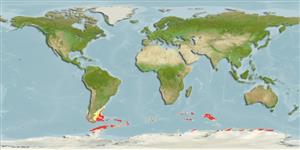Preferred temperature (Ref.
123201): 1.4 - 5.8, mean 3.3 °C (based on 139 cells).
Phylogenetic diversity index (Ref.
82804): PD
50 = 1.0625 [Uniqueness, from 0.5 = low to 2.0 = high].
Bayesian length-weight: a=0.01995 (0.00906 - 0.04395), b=3.01 (2.83 - 3.19), in cm total length, based on all LWR estimates for this body shape (Ref.
93245).
Trophic level (Ref.
69278): 3.7 ±0.54 se; based on food items.
Widerstandsfähigkeit (Ref.
120179): mittel, Verdopplung der Population dauert 1,4 - 4,4 Jahre. (tm=2-3).
Fishing Vulnerability (Ref.
59153): Moderate vulnerability (44 of 100).
Climate Vulnerability (Ref.
125649): High to very high vulnerability (74 of 100).
Nutrients (Ref.
124155): Calcium = 35.3 [15.1, 57.1] mg/100g; Iron = 0.311 [0.153, 0.570] mg/100g; Protein = 18.7 [15.3, 22.4] %; Omega3 = 0.426 [0.222, 0.835] g/100g; Selenium = 23.4 [12.0, 48.1] μg/100g; VitaminA = 7.78 [1.84, 35.15] μg/100g; Zinc = 0.39 [0.27, 0.57] mg/100g (wet weight); based on
nutrient studies. 